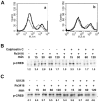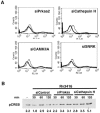Reciprocal regulation of reactive oxygen species and phospho-CREB regulates voltage gated calcium channel expression during Mycobacterium tuberculosis infection
- PMID: 24797940
- PMCID: PMC4010530
- DOI: 10.1371/journal.pone.0096427
Reciprocal regulation of reactive oxygen species and phospho-CREB regulates voltage gated calcium channel expression during Mycobacterium tuberculosis infection
Abstract
Our previous work has demonstrated the roles played by L-type Voltage Gated Calcium Channels (VGCC) in regulating Mycobacterium tuberculosis (M. tb) survival and pathogenesis. Here we decipher mechanisms and pathways engaged by the pathogen to regulate VGCC expression in macrophages. We show that M. tb and its antigen Rv3416 use phospho-CREB (pCREB), Reactive Oxygen Species (ROS), Protein Kinase C (PKC) and Mitogen Activated Protein Kinase (MAPK) to modulate VGCC expression in macrophages. siRNA mediated knockdown of MyD88, IRAK1, IRAK2 or TRAF6 significantly inhibited antigen mediated VGCC expression. Inhibiting Protein Kinase C (PKC) or MEK-ERK1/2 further increased VGCC expression. Interestingly, inhibiting intracellular calcium release upregulated antigen mediated VGCC expression, while inhibiting extracellular calcium influx had no significant effect. siRNA mediated knockdown of transcription factors c-Jun, SOX5 and CREB significantly inhibited Rv3416 mediated VGCC expression. A dynamic reciprocal cross-regulation between ROS and pCREB was observed that in turn governed VGCC expression with ROS playing a limiting role in the process. Further dissection of the mechanisms such as the interplay between ROS and pCREB would improve our understanding of the regulation of VGCC expression during M. tb infection.
Conflict of interest statement
Figures








Similar articles
-
Regulation of L-type Voltage Gated Calcium Channel CACNA1S in Macrophages upon Mycobacterium tuberculosis Infection.PLoS One. 2015 Apr 27;10(4):e0124263. doi: 10.1371/journal.pone.0124263. eCollection 2015. PLoS One. 2015. PMID: 25915405 Free PMC article.
-
Voltage gated calcium channels negatively regulate protective immunity to Mycobacterium tuberculosis.PLoS One. 2009;4(4):e5305. doi: 10.1371/journal.pone.0005305. Epub 2009 Apr 23. PLoS One. 2009. PMID: 19390594 Free PMC article.
-
Suppression of Protective Responses upon Activation of L-Type Voltage Gated Calcium Channel in Macrophages during Mycobacterium bovis BCG Infection.PLoS One. 2016 Oct 10;11(10):e0163845. doi: 10.1371/journal.pone.0163845. eCollection 2016. PLoS One. 2016. PMID: 27723836 Free PMC article.
-
Impaired generation of reactive oxygen species during differentiation of dendritic cells (DCs) by Mycobacterium tuberculosis secretory antigen (MTSA) and subsequent activation of MTSA-DCs by mycobacteria results in increased intracellular survival.J Immunol. 2006 Jul 1;177(1):468-78. doi: 10.4049/jimmunol.177.1.468. J Immunol. 2006. PMID: 16785544
-
Targeting voltage-gated calcium channels for neuropathic pain management.Neurotherapeutics. 2009 Oct;6(4):679-92. doi: 10.1016/j.nurt.2009.07.006. Neurotherapeutics. 2009. PMID: 19789072 Free PMC article. Review.
Cited by
-
Mycobacteria modulate SUMOylation to suppresses protective responses in dendritic cells.PLoS One. 2023 Sep 29;18(9):e0283448. doi: 10.1371/journal.pone.0283448. eCollection 2023. PLoS One. 2023. PMID: 37773921 Free PMC article.
-
Regulation of L-type Voltage Gated Calcium Channel CACNA1S in Macrophages upon Mycobacterium tuberculosis Infection.PLoS One. 2015 Apr 27;10(4):e0124263. doi: 10.1371/journal.pone.0124263. eCollection 2015. PLoS One. 2015. PMID: 25915405 Free PMC article.
-
Pneumococal Surface Protein A (PspA) Regulates Programmed Death Ligand 1 Expression on Dendritic Cells in a Toll-Like Receptor 2 and Calcium Dependent Manner.PLoS One. 2015 Jul 27;10(7):e0133601. doi: 10.1371/journal.pone.0133601. eCollection 2015. PLoS One. 2015. PMID: 26214513 Free PMC article.
-
Drosophila Voltage-Gated Calcium Channel α1-Subunits Regulate Cardiac Function in the Aging Heart.Sci Rep. 2018 May 2;8(1):6910. doi: 10.1038/s41598-018-25195-0. Sci Rep. 2018. PMID: 29720608 Free PMC article.
-
Converging roles of ion channels, calcium, metabolic stress, and activity pattern of Substantia nigra dopaminergic neurons in health and Parkinson's disease.J Neurochem. 2016 Oct;139 Suppl 1(Suppl Suppl 1):156-178. doi: 10.1111/jnc.13572. Epub 2016 Mar 23. J Neurochem. 2016. PMID: 26865375 Free PMC article. Review.
References
-
- World Health Organization (2012) Global tuberculosis control 2012. Available: www.who.org.
-
- Koul A, Herget T, Klebl B, Ullrich A (2004) Interplay between Mycobacteria and host signaling pathways. . Nat. Rev. Microbiol. 2: 189–202. - PubMed
-
- Cantrell D (1996) T cell antigen receptor signal pathways. . Ann. Rev Immunol.14: 259–274. - PubMed
-
- Berridge MJ (1993) Cell signaling. A tale of two messengers. Nature 365: 388–389. - PubMed
-
- Lewis RS (2007) The molecular choreography of a store-operated calcium channel. Nature 446: 284–287. - PubMed
Publication types
MeSH terms
Substances
LinkOut - more resources
Full Text Sources
Other Literature Sources
Miscellaneous

